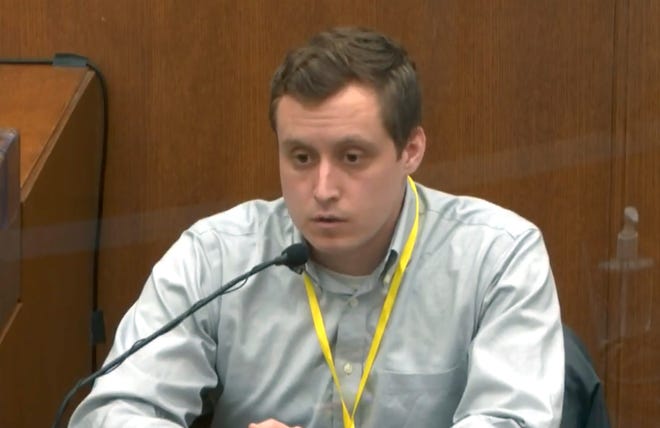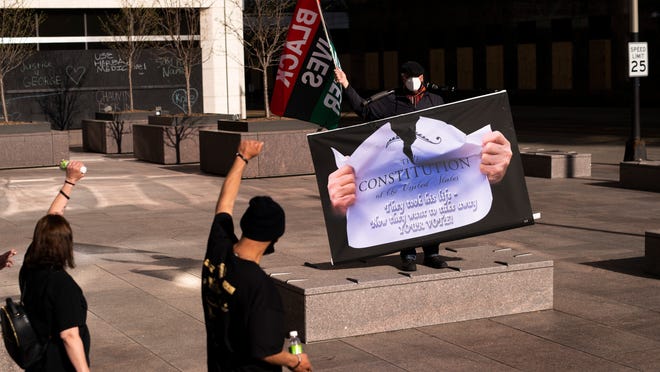MINNEAPOLIS — The man who was in the vehicle with George Floyd last Memorial Day before his struggle with police officers was expected to appear before the court Tuesday for a hearing over potential testimony in the murder trial of former officer Derek Chauvin.
Morries Hall has been subpoenaed to appear as a witness in the trial, but he filed a motion late last month saying he would refuse to answer questions if he’s forced to testify. He was expected to appear via Zoom.
Meanwhile, Minneapolis Police Chief Medaria Arradondo told jurors Monday that Chauvin’s restraint of Floyd “absolutely” violated department policy. He said that the restraint should have stopped “once Mr. Floyd stopped resisting” and “once he was in distress and verbalized it.”
Chauvin is charged with second-degree murder, third-degree murder and second-degree manslaughter. Floyd, a Black man, died in police custody on May 25, 2020, after Chauvin, who is white, pinned his knee against Floyd’s neck for more than nine minutes.
Stay updated on the Derek Chauvin trial: Sign up for text messages of key updates, follow USA TODAY Network reporters on Twitter, or subscribe to the Daily Briefing newsletter.
Latest updates:
- Court was expect to resume at 8:30 a.m. CST Tuesday for a motions hearing, with jurors back in the courtroom at 9:15 a.m.
- Jurors have heard from more than 20 witnesses.
- Katie Blackwell, who led Minneapolis Police Department trainings, said the department trains officers to use one or two arms during a neck restraint – not a knee.
- The doctor who provided emergency care to Floyd at Hennepin County Medical Center testified Monday that at the time of the incident, he believed Floyd died from a lack of oxygen, rather than an overdose or heart attack.
- Public safety officials said Monday the trial has been going “smoothly,” and that there’s nothing to indicate “that there is an imminent threat to the court proceedings or to either of the Twin Cities.”
Morries Hall, who was in vehicle with George Floyd, to appear before the court
Morries Hall was expected to appear before the court Tuesday for a hearing over potential testimony. He is being held at the Hennepin County Public Safety Facility on unrelated charges.
Hall has been subpoenaed to appear as a witness in the trial. However, Hall filed a motion late last month to quash the subpoena on grounds that he would invoke his Fifth Amendment right against incrimination and refuse to answer questions if he’s forced to testify.
Judge Peter Cahill approved Hall’s request to wear civilian clothes and not jail scrubs for the hearing, a court filing shows.
Hall’s name came up in questioning last week. Lead defense attorney Eric Nelson asked Floyd’s girlfriend, Courteney Ross, about Hall. Ross acknowledged that she told FBI investigators Floyd bought narcotics from Hall, but in court she said she “did not see it with my own eyes.”
Ross said she was in a car at a hotel while Floyd bought pills a week before his death. She said she was on the phone with him and thought she heard Hall’s voice in the background. She testified that she only learned afterward that Floyd was with Hall the day Floyd died.
Minneapolis Police Chief Medaria Arradondo: Restraint of Floyd ‘absolutely’ violates policy
Minneapolis Police Chief Medaria Arradondo, who fired Derek Chauvin and three other officers involved in the incident, said Monday under questioning that he believed Chauvin was trying to employ a conscious neck restraint on Floyd, which involves using light to moderate pressure on a person who is actively resisting police, according to the department’s policy.
But while viewing a still-frame of Chauvin kneeling on Floyd’s neck, Arradando said from the picture and Floyd’s facial expression, it “does not appear in any way, shape or form, that that is light to moderate pressure.” Arradando added: “I vehemently disagree that that’s the appropriate use of force for that situation.”
The restraint should have stopped “once Mr. Floyd stopped resisting” and “once he was in distress and verbalized it,” Arradondo said. He added that “there’s an initial reasonableness in trying to get him under control in the first few seconds” only.

“And clearly when Mr. Floyd was no longer responsive and even motionless, to continue to apply that level of force to a person proned out, handcuffed behind their back. That in no way shape or form is not backed by policy, it is not backed by our training, and it’s certainly not our ethics or our values,” Arradondo said.
Arradondo said the officers violated department policy by failing to give first aid to Floyd when he appeared to not be breathing, while they waited for an ambulance.
On cross-examination by defense attorney Eric Nelson, Arradondo acknowledged that he had not made an arrest, personally, in many years. He also acknowledged that in a side-by-side comparison of bystander video and an officer’s body-cam video, it appears that in the latter, Chauvin’s knee is more on Floyd’s shoulder blade than on his neck.
The moment in the video came at the end of the incident, after paramedics arrived and checked Floyd’s neck for a pulse. In the body-cam video, Chauvin can be seen shifting his knees and leaning back slightly.
Doctor tells jurors he believed lack of oxygen, not overdose or heart attack, was ‘most likely’ cause of death
Dr. Bradford Langenfeld testified Monday morning, telling jurors he directed the care of Floyd at Hennepin County Medical Center and spent about 30 minutes trying resuscitate him before pronouncing him dead.
Questioned by prosecutor Jerry Blackwell, Langenfeld said the paramedics who brought Floyd to the hospital did not give him any information that Floyd might have overdosed on drugs or suffered a heart attack.
Langenfeld said Floyd had some electrical activity around the heart, but no pulse. Floyd’s heart never resumed beating on its own “to a degree necessary to sustain life,” he said.

Asked by Blackwell what was determined to be the cause of Floyd’s cardiac arrest, Langenfeld said: “At the time, based on the history available to me, I felt that hypoxia was one of the most likely possibilities.” Hypoxia is a lack of oxygen, which Langenfeld said he believed led to Floyd’s death from asphyxia.
During cross-examination by lead defense attorney Eric Nelson, Langenfeld acknowledged that a combination of fentanyl and methamphetamine could cause hypoxia. A toxicology screen of Floyd after his death found fentanyl and methamphetamine in his system.



















